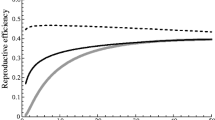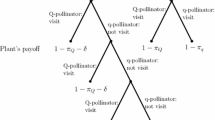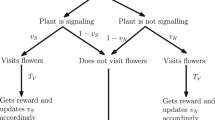Summary
A game theoretic model was developed for nectar secretion in animal-pollinated plants in order to examine how the total amount of resources allocated to flowers affects the spread of nectarless plants. It was assumed that pollinators concentrate on patches whose nectar rewards are relatively large compared to other patches and if pollinators visit a patch, they concentrate on the plants whose nectar rewards are relatively large compared to other plants in the patch. It was shown that plants are more likely to secrete nectar in populations where the total amount of resources allocated to flowers is large. It was also shown that strong interplant competition, strong interpatch competition and the nectar discrimination of the pollinators are also important factors for nectar secretion. However, if the total amount of resources allocated to flowers is sufficiently large, plants would secrete nectar even if competition is not very strong and nectar discrimination is not so precise.
Similar content being viewed by others
References
Bell, G. (1986) The evolution of empty flowers.J. Theor. Biol. 118, 253–8.
Bell, G., Lefebvre, L., Giraldeau, L.-A. and Wearly, D. (1984) Partial preference of insects for the male flowers of an annual herb.Oecologia 64, 287–94.
Frisch, K. von (1967)The Dance Language and Orientation of Bees. Belknap Press, Cambridge, MA, USA.
Galen, C. and Plowright, R.C. (1985) The effects of nectar level and flower development on pollen carry-over in inflorescences of fireweed (Epilobium angustifolium) (Onagraceae).Can. J. Bot. 63, 488–91.
Gill, F.B. and Wolf, L.L. (1977) Nonrandom foraging by sunbirds in a patchy environment.Ecology 58, 1284–96.
Harder, L.D. (1982) Measurement and estimation of functional proboscis length in bumblebees (Hymenoptera: Apidae).Can. J. Zool. 60, 1073–9.
Harder, L.D. (1983) Flower handling efficiency of bumble bees: morphological aspects of handling time.Oecologia 57, 274–80.
Heinrich, B. (1979)Bumble-bee Economics. Harvard University Press, Cambridge, MA, USA.
Hodges, C.M. (1985) Bumble bee foraging: the threshold departure rule.Ecology 66, 179–87.
Kato, M. (1988) Bumblebee visits toImpatiens spp.: pattern and efficiency.Oecologia 76, 364–70.
Marden, J.H. (1984) Remote perception of floral nectar by bumble bees.Oecologia 64, 232–40.
Morse, D.H. (1980). The effect of nectar abundance on foraging patterns of bumble bees.Ecol. Entomol. 5, 53–9.
Pleasants, J.M. and Zimmerman, M. (1979) Patchiness in the dispersion of nectar resources: evidence for hot and cold spots.Oecologia 41, 283–8.
Pleasants, J.M. and Zimmerman, M. (1983) The distribution of standing crop of nectar: what does it really tell us?Oecologia 57, 412–14.
Pyke, G.H. (1978a) Optimal foraging in bumblebees and coevolution with their plants.Oecologia 36, 281–93.
Pyke, G.H. (1978b) Optimal foraging: movement patterns of bumblebees between inflorescences.Theor. Pop. Biol. 13, 72–98.
Real, L. and Rathcke, B.J. (1991) Individual variation in nectar production and its effect on fitness inKalmia latifolia.Ecology 72, 149–55.
Schmitt, U. and Bertsch, A. (1990) Do foraging bumblebees scent-mark food sources and does it matter?Oecologia 92, 137–44.
Thomson, J.D. (1988) Effects of variation in inflorescence size and floral rewards on the visitation rates of traplining pollinators ofAralia hispida.Evol. Ecol. 2, 65–76.
Thomson, J.D. and Plowright, R.C. (1980) Pollen carryover, nectar rewards, and pollinator behavior with special reference toDiervilla lonicera.Oecologia 46, 68–74.
Thomson, J.D., Maddison, W.P. and Plowright, R.C. (1982) Behavior of bumble bee pollinators ofAralia hispida Vent. (Araliaceae).Oecologia 52, 326–36.
Waddington, K.D., Allen, T. and Heinrich, B. (1981) Floral preferences of bumblebees (Bombus edwardsii) in relation to intermittent versus continuous rewards.Anim. Behav. 29, 779–84.
Wetherwax, P.B. (1986) Why do honeybees reject certain flowers?Oecologia 69, 567–70.
Zimmerman, M. (1981a) Nectar dispersion patterns in a population ofImpatiens capensis.Virginia J. Sci. 32, 150–2.
Zimmerman, M. (1981b) Patchiness in the dispersion of nectar resources: probable causes.Oecologia 49, 154–7.
Zimmerman, M. (1982) The effect of nectar production on neighborhood size.Oecologia 52, 104–8.
Zimmerman, M. (1983) Plant reproduction and optimal foraging: experimental nectar manipulation inDelphinium nelsonii.Oikos 41, 57–63.
Zimmerman, M. (1988) Nectar production, flowering phenology, and strategies for pollination. InPlant Reproductive Ecology: Patterns and Strategies (J. Lovett Doust and L. Lovett Doust, eds) pp. 157–78. Oxford University Press, Oxford, UK.
Zimmerman, M. and Cook, S. (1985) Pollinator foraging, experimental nectar robbing and plant fitness inImpatiens capensis.Am. Midl. Nat. 113, 84–91.
Zimmerman, M. and Pyke, G.H. (1986) Reproduction in Polemonium: patterns and implications of floral nectar production and standing crops.Am. J. Bot. 73, 1405–15.
Author information
Authors and Affiliations
Rights and permissions
About this article
Cite this article
Sakai, S. A model for nectar secretion in animal-pollinated plants. Evol Ecol 7, 394–400 (1993). https://doi.org/10.1007/BF01237870
Issue Date:
DOI: https://doi.org/10.1007/BF01237870




